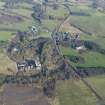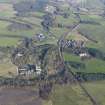Following the launch of trove.scot in February 2025 we are now planning the retiral of some of our webservices. Canmore will be switched off on 24th June 2025. Information about the closure can be found on the HES website: Retiral of HES web services | Historic Environment Scotland
Shotts, Hartwood Hospital
Psychiatric Hospital (19th Century)
Site Name Shotts, Hartwood Hospital
Classification Psychiatric Hospital (19th Century)
Alternative Name(s) District Asylum For Lanark
Canmore ID 151924
Site Number NS85NW 18
NGR NS 84273 58956
Datum OSGB36 - NGR
Permalink http://canmore.org.uk/site/151924
- Council North Lanarkshire
- Parish Shotts (Motherwell)
- Former Region Strathclyde
- Former District Motherwell
- Former County Lanarkshire
NS85NW 18.00 84273 58956
Not to be confused with Hill (Hartwoodhill Hospital) for which see NS85NE 55.00
NS85NW 18.01 84479 59132 Hartwood House
NS85NW 18.02 84183 58894 Ward 1
NS85NW 18.03 84330 59007 Ward 6
NS85NW 18.04 84305 59123 Wards 9, 10
NS85NW 18.05 84372 59166 Clachan House
NS85NW 18.06 84302 59256 Sanatorium
NS85NW 18.07 84352 59063 Bowling green pavilion
NS85NW 18.08 84738 58833 Nurses' home
NS85NW 18.09 84277 59043 From 84291 58979 to 84277 59120 East Corridor
NS85NW 18.10 84192 58941 Ward 2
NS85NW 18.11 84154 58972 Ward 3
NS85NW 18.12 84209 58979 Boiler house
NS85NW 18.13 84184 59020 Laundry
NS85NW 18.14 84232 59025 Workshops
NS85NW 18.15 84354 59025 Ward 16
Group of Baronial-style hospital buildings which are surviving elements of once much larger complex on the site. Large 2-storey, double pitched and gabled central administration block with advanced gabled bay to centre and 6-stage paired square clock towers to rear (NW) corners. Pair of 3-storey villa style ward blocks set back to left and right and linked to main block by remnants of glazed corridors which also link to large single storey roughly T-plan range of ancillary buildings to rear. Clock towers with single round angle stair turrets to front corners, crenulated parapets and openings to former clock faces to each side (clock faces damaged). Bull-faced cream sandstone rubble masonry with ashlar dressings. Canted bays, transomed and mullioned windows and crowstepped gables.
The remaining buildings of the former Hartwood Hospital site are an important remnant of the extensive late 19th century asylum hospital complex which was designed with fine Scots Baronial features and stonework including prominent paired clock towers and near symmetrical flanking wings. The surviving buildings act as striking architectural landmarks in the wider open landscape. The hospital blocks were constructed in a diversified plan to accommodate increasing specialisation in the care of psychiatric patients. The main Hartwood Hospital building block with central towers and side wings was designed and built from 1890 by the local architect J L Murray from Biggar as the Lanark District Asylum covering the Lanarkshire area. The 1857 Lunacy (Scotland) Act required all areas to build a District Asylum for its 'pauper lunatics'. The need for more diverse classification of the patients and the better management of different types of psychiatric conditions in the late 19th century led to a wider variety of building types and plans for hospitals built during this period. Hartwood was purposely built on an isolated site for exclusion. The initial build took five years to complete at a cost of £153,000, opening on 14th May 1895 and able to house 420 residents. The industrialisation of the surrounding area boosted the local population and resident numbers rose accordingly reaching 960 by 1913. The expansion required more building and another local architect James Lochhead was commissioned to build more wards and other buildings; a sanatorium in 1904, new reception block in 1916, and male staff hostel in 1936. The largest, and only remaining, one of these was the Nurses Home accommodation built from 1926 and opened in 1931 (see separate listing). Most of the buildings were linked by glazed enclosed external walkways to control the movement of the patients around the site. By the mid 1950s Hartwood Hospital was a fully independent site which had created a hospital "village" with a variety of facilities including a bowling green, arcade of shops and a dancehall. The village system of patient care, exemplified by the Alt-Scherbitz hospital, near Leipzig in Germany in the 1870s encouraged psychiatric patients to be cared for within their own community setting. Hartwood was the largest asylum in Europe housing 2,500 residents. The introduction of the 1990 Community Care Act resulted in psychiatric care moving to the community and subsequent redundancy for the Hartwood Hospital buildings. From 1995 the hospital buildings moved to administration only and were totally vacated in 1998 to the nearby Hartwoodhill Complex. The majority of the later ward blocks on site were demolished during this period leaving only the main towers and flanking blocks and the ancillary buildings to the rear. Those that remain were damaged by fires in 2004 and 2011, with further damage by vandalism. The separate single storey laundry, boiler block and other ancillary blocks to the north of the site were not considered to be of special architectural or historic interest at the time of the review, 2013. (Historic Scotland)


































































































